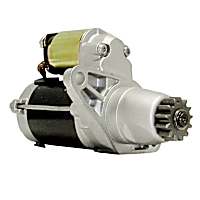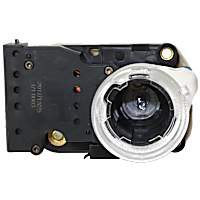When a car doesn’t start, many people assume that the starter motor is to blame. From a service standpoint, there’s a difference between a “no start” concern and a “no crank” concern. A “no start” is typically a “spins normally but won’t start” issue rather than a condition where the engine spins too slowly or not at all.
After all, the component we’re talking about here has the term “start” right in its name. But in reality, there are dozens of potential reasons why a car might not fire up.
That’s why it’s helpful to know the symptoms of a bad starter. Once you have an idea of what to look for, you (or your mechanic) can perform a thorough diagnosis to confirm whether the starter is to blame.

Bad Starter Symptoms
The starter is a small motor (with a drive assembly) that turns the engine over to get the car started. Just about every starter used over the past 30 years has been a small permanent magnet-type motor connected to the starter drive by way of a planetary gearset. That enables the manufacturer to use a smaller, lighter starter than cars used up through most of the 1980s. The starter is also called the starter motor, cranking motor, or car crank starter. Usually, it’s just called the “starter.”
It’s important to note that the starter turns (cranks) the engine. If your engine cranks normally but does not start, the starter motor is not to blame unless it is pulling too much current and the engine is spinning too slowly because the starter doesn’t have the power to spin the engine fast. Such a scenario points toward an issue with air/fuel delivery, spark delivery, or compression, rather than a bad starter.
Another thing to remember is that problems with other parts of the vehicle can mimic many of the symptoms associated with a bad starter. Never assume the starter is to blame without doing some troubleshooting.
With that in mind, let’s take a look at the common signs of a bad starter:
Engine Won’t Crank or Start
The most obvious sign of a bad starter is an engine that won’t crank or start. Of course, there are many other issues besides a bad starter that can prevent the engine from cranking. A few examples include a bad battery, failed ignition switch, a locked up accessory (water pump or A/C compressor pulley bearing, etc.) or an engine mechanical problem.
If you hear a rapid clicking when trying to start the car, that usually points to a bad battery or a bad battery cable connection either at the battery, at the starter, or at the engine block where the ground cable is connected.
Another consideration is voltage drop at one of the connections or within the solenoid itself, which could open the subject of a whole new article. Voltage drop can cause a starter to burn itself out very quickly.
In any scenario, you’ll want to perform a thorough diagnosis to determine the root cause of a no-crank or slow-crank concern.
Engine Cranks Slowly
An internal problem with the starter motor can cause the engine to crank slowly. But the problem can also be caused by other issues, such as a weak battery, a partially seized belt driven accessory, or internal engine problem.
You’ll need to do your homework to determine whether the starter is to blame.

Grinding Noise While Starting the Engine
If the teeth on the starter pinion gear are damaged, or the starter fails to retract soon enough once the engine is running, you’ll hear a grinding noise while starting the engine.
The problem can also result from damaged teeth on the flywheel (or flexplate) that mesh with the starter gear.
Whirring Noise When Trying to Start the Engine
A defective starter drive can allow the pinion gear to freewheel during engine cranking, resulting in a whirring or whining noise.
The starter drive has an internal one-way clutch that can sometimes fail and cause the starter to begin spinning the engine. When the one-way clutch doesn’t hold, the starter will continue to spin without spinning the engine at all.
In most cases, because the pinion gear isn’t engaging the flywheel properly, the engine will also fail to crank.
Engine Intermittently Fails to Crank or Start
Like most other electrical devices, the starter motor can experience intermittent failure, resulting in an engine that occasionally fails to crank or start.
How Does a Starter Work?
The starter contains a motor, as well as a drive assembly with a pinion gear. During cranking, the pinion gear meshes with the engine’s toothed flywheel (or a flexplate if the car has an automatic transmission).

Most starters also contain a solenoid (though the solenoid or relay can be located remotely) that acts as a type of switch to engage the starter.
When you turn the key to start your car, the solenoid core, a heavy metal cylinder, reacting to the magnetic field in the solenoid winding, first moves toward the back of the starter to ram a thick copper washer against the two studs that make the connection from the battery to the starter motor.
But before it snaps the heavy copper contact against the two posts (see illustration), it operates a lever that engages the starter drive teeth in the flywheel. The starter should never begin to spin until the teeth of the starter drive are fully engaged in the flywheel.
The starter motor then spins the pinion gear, which, in turn, rotates the flywheel to crank the engine. Usually the gear ratio of the starter drive to the number of flywheel teeth is about 14 to 1, but it varies.
Check out these videos on how to replace your starter:
How Do You Troubleshoot a Car Starter When the Car Won’t Start?
An old trick mechanics often use is to bang on the starter with a rubber mallet to see if the engine cranks.
If the car starts after the starter is given a few whacks, you know the starter is faulty. The reason this works is because the brushes wear out over time and usually one of them will have a voltage drop condition that can be overcome by bumping the starter. But don’t hit it hard with a steel hammer or you may break the permanent magnets.
The problem is the rubber mallet test only works in limited instances. To properly diagnose the starter in a no-crank situation, you’ll want to follow the steps outlined below.
Note: The following are general guidelines for educational and entertainment purposes only. Consult your vehicle’s factory information for specific repair instructions and recommended safety procedures.
Test the Battery
Because batteries fail far more often than starters, you’ll want to test the battery before you go any further. Make sure the battery terminals are also clean and tight, and that the battery cables are in good condition.

You can test a battery’s state of charge using a digital multimeter (DMM). To do so, follow these steps:
- Put on your safety glasses.
- Set the DMM to the 20 volts DC setting.
- Connect the black meter lead to the negative battery terminal and the red meter lead to the positive battery terminal, right in the center of the battery post.
- A battery that’s sufficiently charged should have at least 12.2 volts.
- If your battery has less than about 12 volts, you’ll want to charge it, then test it with a load tester. Most people don’t have access to a load tester, but nearly all auto parts stores do, and they’ll test your battery free of charge.
- With the meter still connected, try to spin the starter. If the voltage remains the same and the starter doesn’t spin, move your test leads to the battery cable terminals and try the test again. If the voltage at the battery terminal end drops significantly but the measured battery voltage remains at just over 12 volts, clean the terminals.
Here is a video that demonstrates the steps above:
Perform a Voltage Drop Test
This test is most commonly performed by professional mechanics but is the most useful test of the connections between the battery and the starter. If you get more voltage drop than the specified amount, find out where the bad connection is and repair it.

Check that Power is Getting to the Starter Solenoid
If the battery is okay, next, you’ll want to ensure that power is getting to the solenoid on top of the starter. You can do this with a DMM.
Here’s how it’s done:
- Put on your safety glasses.
- Set the DMM to the 20 volts DC setting.
- Connect the black meter lead to the negative battery terminal and the red meter lead to the control terminal on the starter solenoid.
- Have a friend turn the ignition key to the start position.
- You should see battery voltage on your meter. If not, there’s a problem somewhere in the starter control circuit you’ll need to hunt down.

On the other hand, if there’s battery voltage present all the way to the solenoid, the starter is likely faulty. But there are a couple of additional steps you should take to be sure.
Bench Test the Starter
By this point, you’ve ensured battery voltage is getting to the solenoid on top of the starter. That rules out a control circuit problem and points to either a bad starter, high resistance in the starter power/ground circuits, or an engine mechanical problem.
To confirm the starter is to blame, you’ll want to remove it and bench test it.
Connect a good battery to the starter housing and the main battery post using jumper cables, then apply voltage from the same source to the solenoid S terminal. Have somebody hold the starter securely because when it begins to spin it will try to aggressively roll. If it spins slowly or with great effort, the starter needs to be replaced.
You can attempt to test it yourself, as outlined in the video below:
Where to Find a New Starter for Your Vehicle
Bad starters can cause a lot of damage to your engine, and driving with one is a slippery slope that usually leads to costly repairs. On the bright side, it only takes a few minutes to shop online for the perfect starter replacements here at CarParts.com.
Why scour auto parts stores for replacement starters when you can find exactly what you need and check out securely with just a few clicks here at CarParts.com? Choose from our wide selection of OE-grade starters sold at unbeatable prices. All our products are on hand and ready to ship, so you can get your order in as fast as two business days.
Use our vehicle selector and filters to view the starters that fit your daily driver and have the specs you want. Don’t hesitate to reach out to our friendly customer service team if you have questions.
Why hold off on getting a new starter for your vehicle? Check out our top-notch starters today!
Products Mentioned in this Guide
Any information provided on this Website is for informational purposes only and is not intended to replace consultation with a professional mechanic. The accuracy and timeliness of the information may change from the time of publication.



 Starter
Starter
 Ignition Switch
Ignition Switch





























